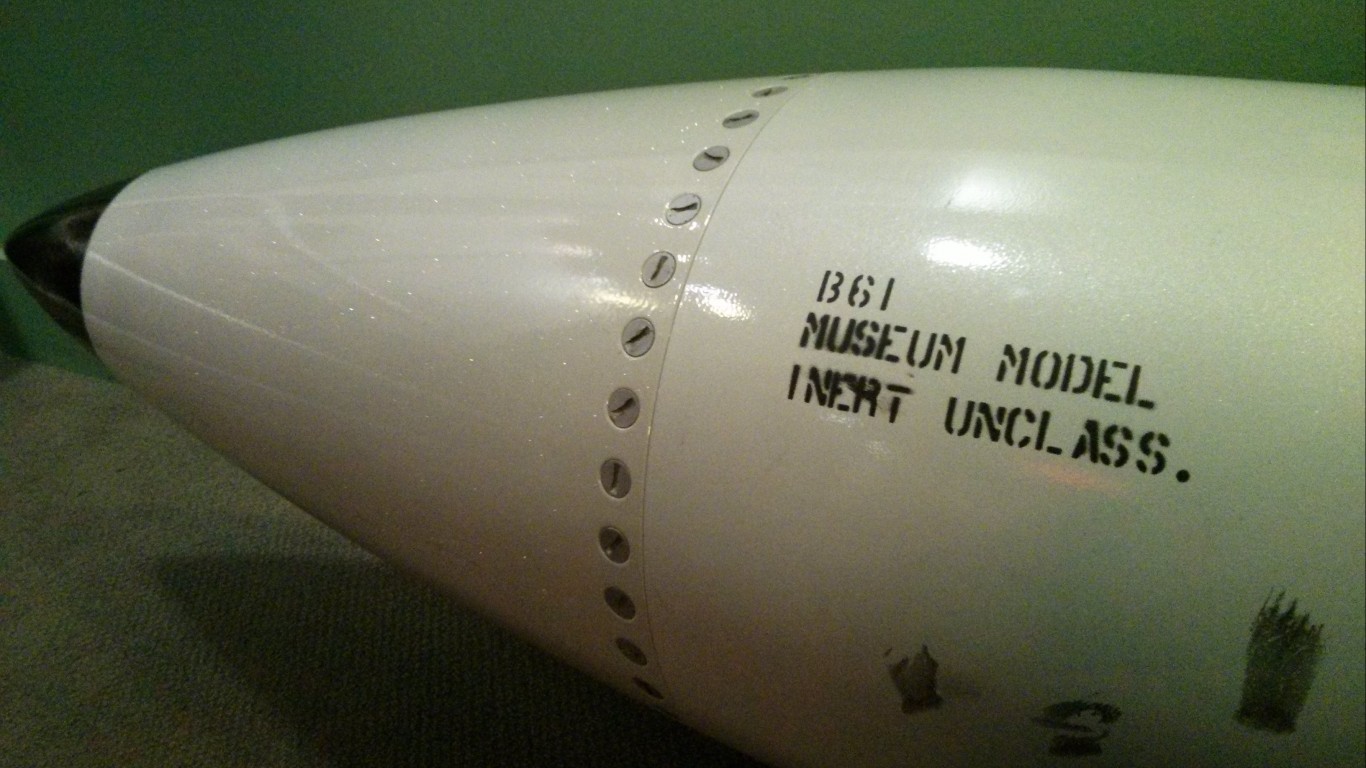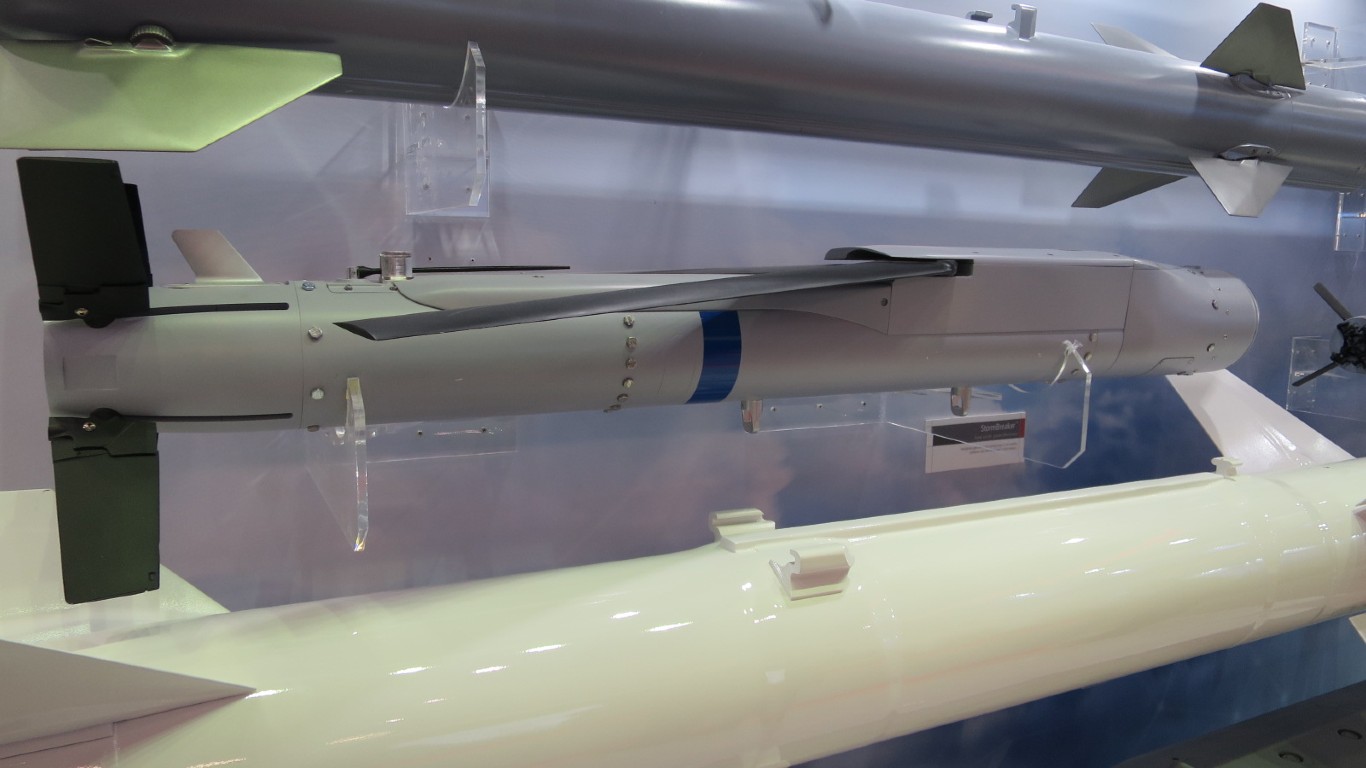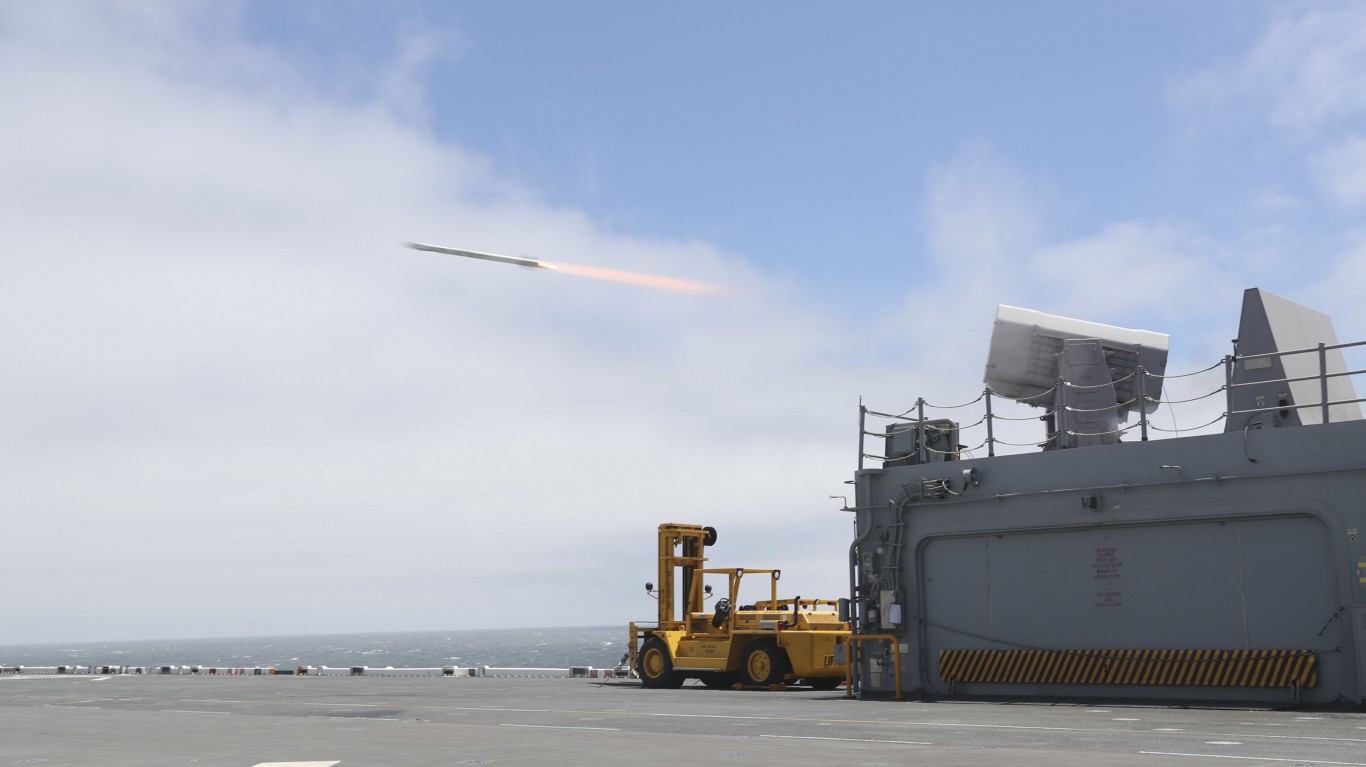
Precision-Guided Munitions, or PGMs, can place a multi-ton warhead within 10 feet of a target from hundreds of miles away. Defined by the Department of Defense as “[a] guided weapon intended to destroy a point target and minimize collateral damage,” precision munitions – including guided bombs, missiles, and rockets – were first used in the Second World War.
Now equipped with GPS and laser guided internal navigation systems, precision munitions are integral to American military operations. In fiscal 2022, the DOD requested $3.5 billion for PGM programs.
24/7 Wall St. reviewed congressional research reports and military documents and publications to identify the bombs used by the U.S. military. These weapons include defensive missiles designed to intercept approaching threats as well as tactical missile systems and strategic nuclear weapons. Some of the systems on the list have never been deployed, while others have been routinely used for decades.
The majority of the bombs on this list were developed for use by the U.S. Navy and Air Force and account for a considerable share of the U.S. military budget. The Sidewinder missiles integrated on F-16 and F-22 fighters, for example, cost just under half a million dollars a piece. (Here is a look at the 35 billion-dollar weapons in the 2024 U.S. military budget.)
Defense contractors, in collaboration with the military, spent years developing and testing the weapons on this list. Companies behind these munitions include many of the largest defense contractors in the world, including Boeing, Lockheed Martin, Northrop Grumman, and Raytheon.
It is important to note that while technological advances have improved the accuracy of these weapons in recent year and reduced the likelihood of collateral damage, precision bombings still often result in civilian casualties. (Here is a look at the 20 most lethal weapons in modern warfare.)
These are the bombs and missiles used by the US military.

1. A/U/RGM-84 Harpoon
> Bomb type: Anti-ship missile
> Service branch user(s): U.S. Navy and Air Force
> Made by: Boeing
The A/U/RGM-84 Harpoon is an anti-ship missile that can be fired from the air, surface vessels, and submarines. Harpoon missiles range in size from about 12.5 feet to 15 feet long and can weigh over 1,500 pounds. They are guided by radar and have a low-level flying trajectory. Initially developed in the 1970s as a standard fleetwide missile for the Navy, the Harpoon is now also used by the Air Force. Some B-52 bombers are capable of carrying up to a dozen Harpoon missiles.
Harpoon missiles are also widely used by foreign countries. Denmark recently provided Ukraine with Harpoon missiles to counter Russian naval activity in the Black Sea. Some 60 Harpoon missiles worth a reported $1.1 billion are also a part of a planned arms sale from the U.S. to Taiwan.
[in-text-ad]
2. AGM-114 Hellfire
> Bomb type: Air-to-surface weapon
> Service branch user(s): U.S. Navy, Army, Air Force, and Marine Corps
> Made by: Lockheed Martin and Northrop Grumman
The AGM-114 Hellfire is a precision, laser guided missile typically fired from the air. It is effective against any tank in the world as well as bunkers, helicopters, buildings, personnel, and some slow-moving fixed-wing aircraft.
Hellfire missiles are the primary weapons carried by MQ-9 Reaper drones. Earlier this year, al-Qaeda leader Ayman al-Zawahiri was killed by a Hellfire missile modified with metal blades rather than a warhead to minimize collateral damage.

3. AGM-154 JSOW
> Bomb type: Long-range standoff weapon
> Service branch user(s): U.S. Navy and Air Force
> Made by: Raytheon
The AGM-154 Joint Standoff Weapon – or JSOW – is an air-to-surface missile weighing about 1,000 pounds and capable of delivering a range of warheads tailored for specific targets. The missiles have a low-altitude range of 12 nautical miles and high-altitude range of 70 nautical miles. AGM-154s are carried by the Air Force in B-1, B-2, and B-52 bombers, and F-15E and F-16 fighter jets as well as by the Navy’s F-18s and F-35s.
Over 400 of the AGM-154A variant have been used in combat, including many carried by F/A-18 fighter jets during the U.S. wars in Afghanistan and Iraq.
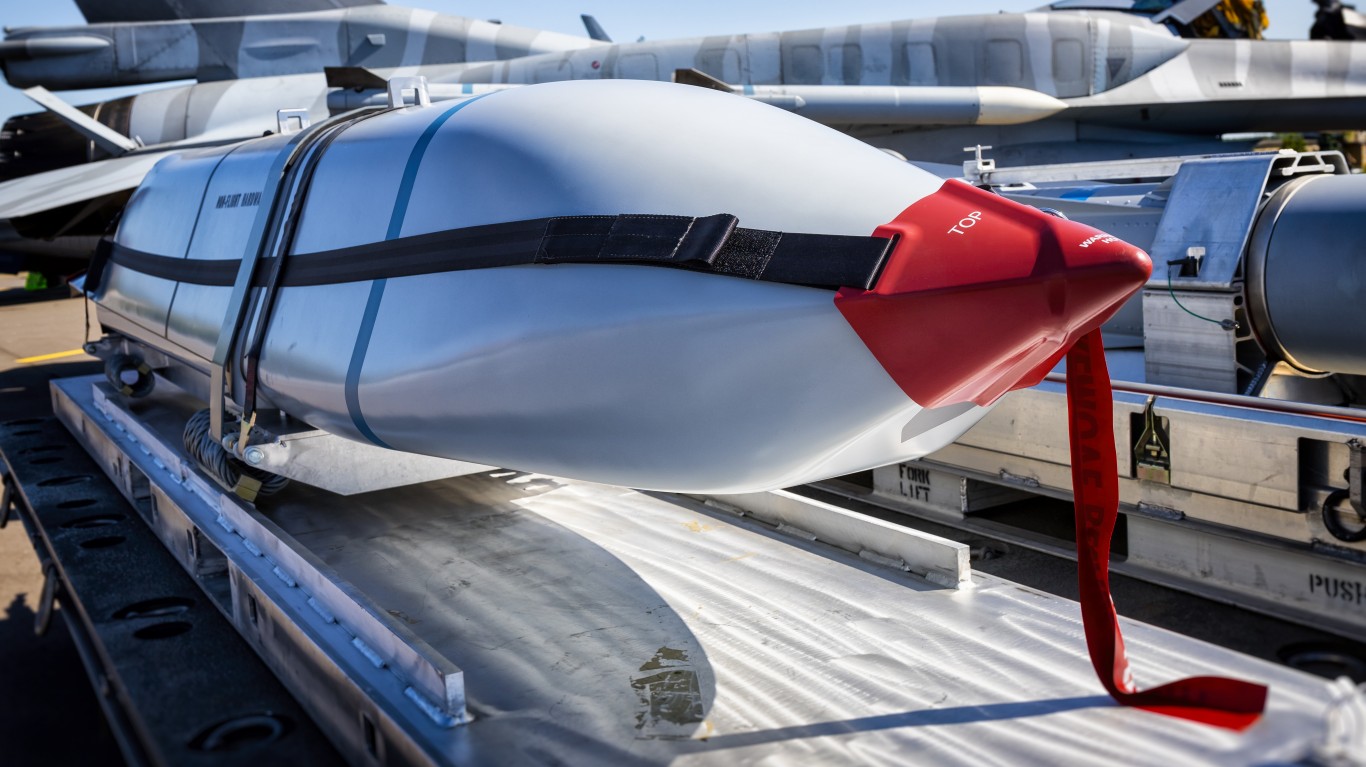
4. AGM-158
> Bomb type: Long-range standoff weapn
> Service branch user(s): U.S. Air Force and Navy
> Made by: Lockheed Martin, Raytheon, and Honeywell
Variations of the AGM-158, used by the U.S. Navy and Air Force, include the Joint Air-to-Surface Strike Missile, or the JASSM, and the Long-Range Anti-Ship Missile, or LRASM. The precision cruise missiles, fitted with 1,000 pound warheads, are designed to take out heavily defended, high-value targets. Depending on the type, these missiles have a range of 200 miles to 1,000 miles.
AGM-158s are carried by fighter jets and bombers. As of 2019, the Air Force had procured over 4,000 JASSMs and announced plans to acquire up to 410 LRASMs. Foreign buyers of AGM-158s include Australia, Finland, and Poland.
[in-text-ad-2]
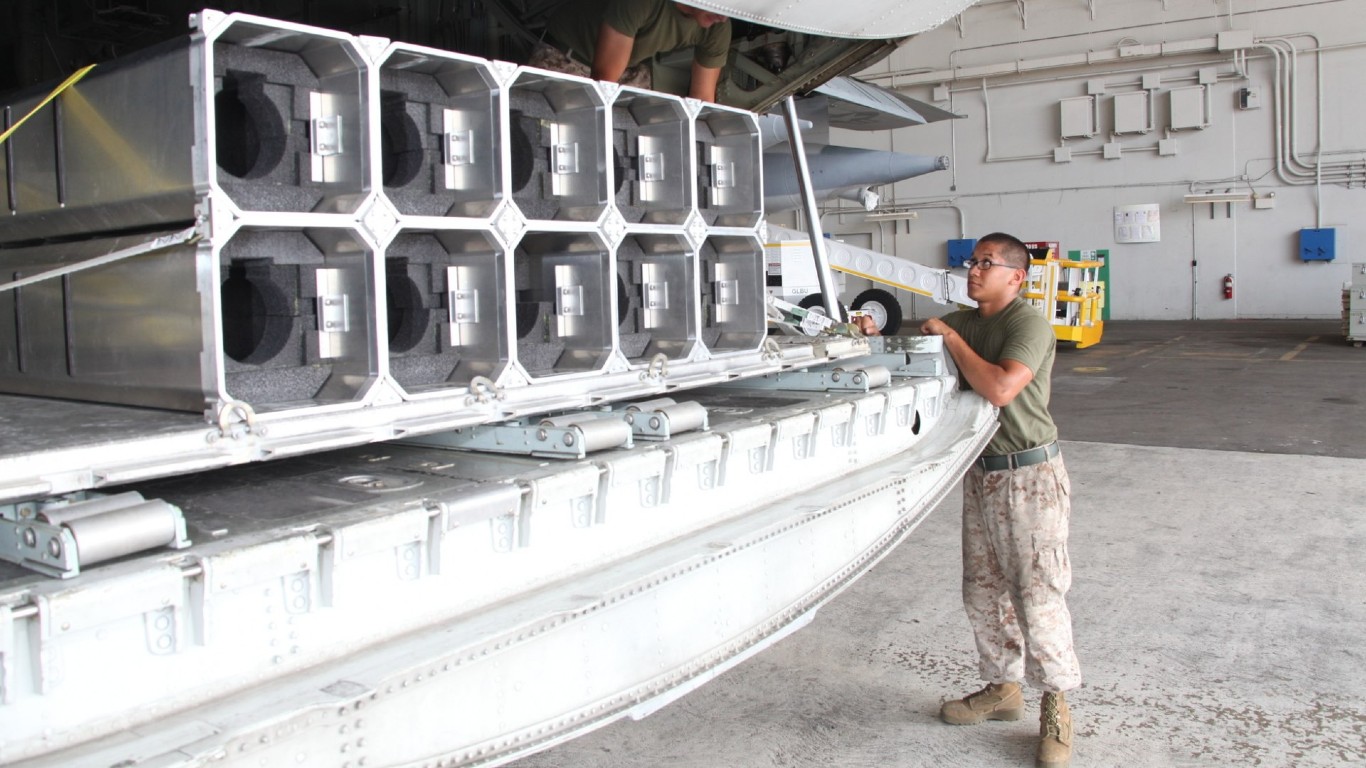
5. AGM-176 Griffin
> Bomb type: Air-to-surface weapon
> Service branch user(s): U.S. Air Force, Marine Corps
> Made by: Raytheon
The Griffin, or AGM-176, is a relatively low-cost, air-launched missile with a range of about 12 miles. GPS and laser guided, the missiles are high precision and effective against light surface targets.
Used primarily by the Air Force, Griffins can be loaded onto AC-130 gunships or MQ-9 Reaper drones. Just shy of 4 feet in length and only 5.5 inches in diameter, aircraft can carry three Griffin missiles in the space a single Hellfire missile would occupy.
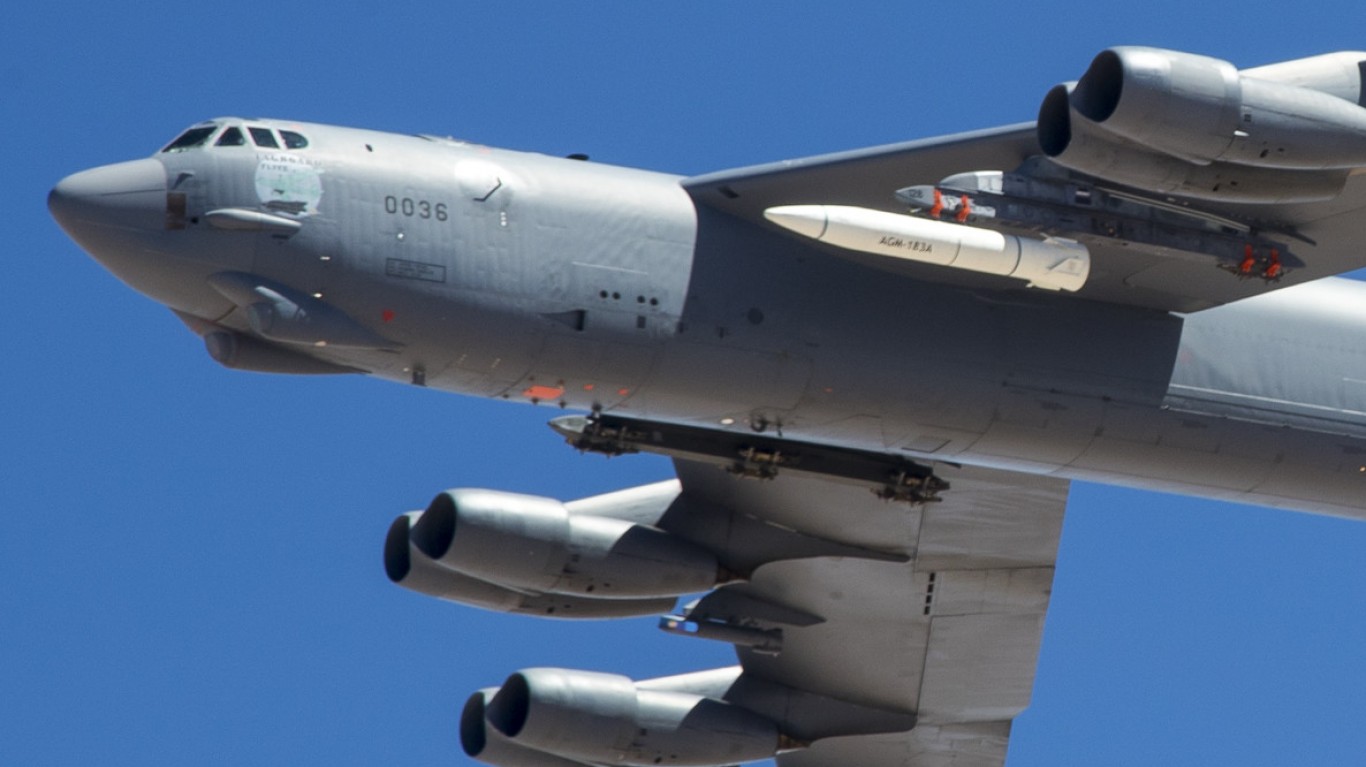
6. AGM-183 ARRW
> Bomb type: Strategic weapon
> Service branch user(s): U.S. Air Force
> Made by: Lockheed Martin
The AGM-183 Air Rapid Response Weapon, or ARRW, represents the cutting edge of hypersonic missile development and may soon be the latest addition to the arsenal of the U.S. Air Force. The ARRW has a range of over 1,000 miles and can reach speeds above Mach 5 before delivering its payload through a non-powered glide vehicle that maneuvers to the target.
After a series of setbacks, including three failed tests and additional budget request requirements, the Air Force conducted its first successful test of the missile system on May 14, 2022. The ARRW is slated for integration onto B-1 and B-52 bombers, as well as F-15 fighter jets – though exactly when ARRW missile is fielded remains to be seen.
[in-text-ad]

7. AGM-65 Maverick
> Bomb type: Air-to-surface weapon
> Service branch user(s): U.S. Navy, Marine Corps, and Air Force
> Made by: Raytheon and Northrop Grumman
Used by the U.S. military since the Vietnam War, the AGM-65 Maverick is an air-to-surface missile system with a range of 20 miles. A versatile system, the Maverick can be fitted with warheads that detonate on impact as well as 300 pound warheads on a time delay that detonate after penetrating the target. Mavericks are effective against a range of targets, including tanks, vehicles, ships, air defenses, and buildings.
Maverick missiles were used widely in Iraq – both in Desert Storm and Iraqi Freedom – as well as Afghanistan. Maverick missiles are used by some Air Force A-10 Thunderbolts, F-15s, and F-16s, as well as Navy P-3, AV-8, and F/A-18 aircraft.
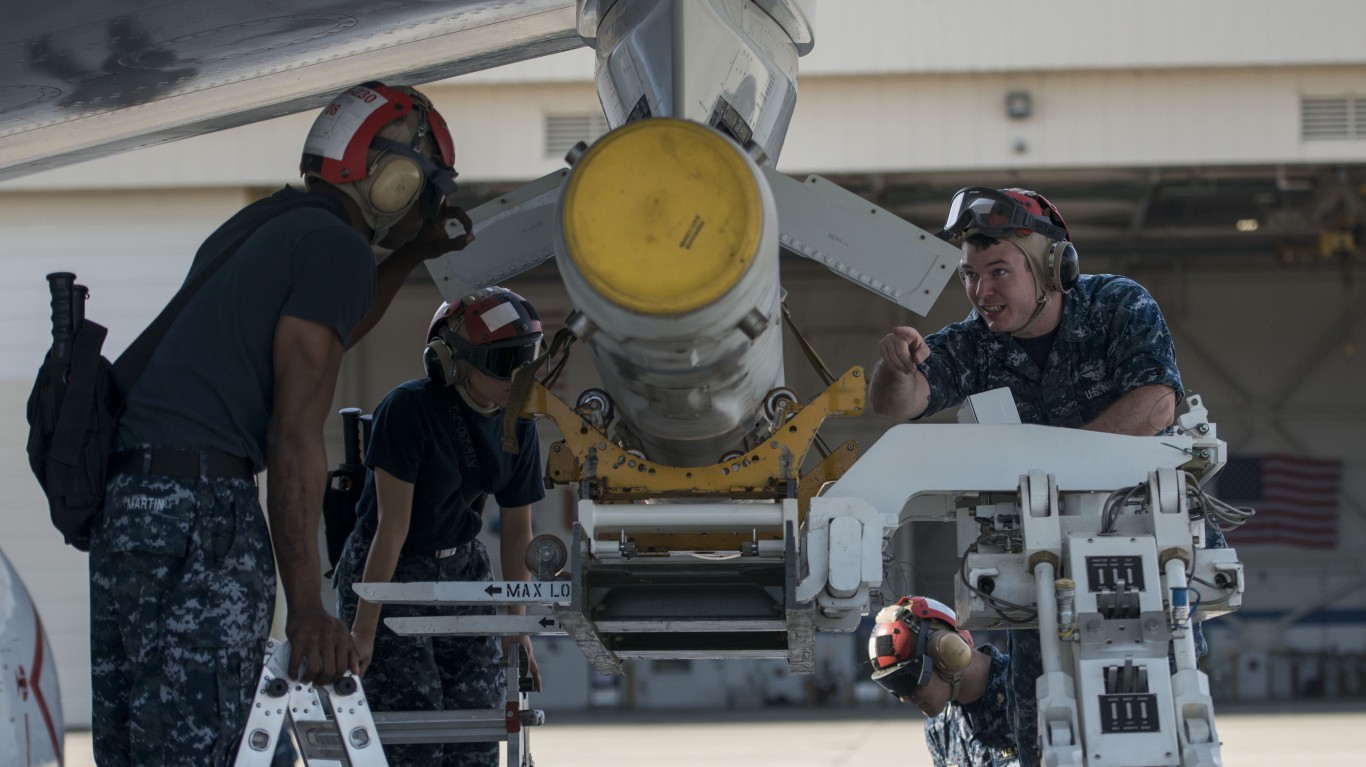
8. AGM-84K SLAM-ER
> Bomb type: Air-to-surface weapon
> Service branch user(s): U.S. Navy
> Made by: Boeing
The AGM-84K Standoff Land Attack Missile-Expanded Response, or SLAM-ER, was the Navy’s first weapon with automatic target acquisition capabilities, making it highly accurate even in cluttered combat environments. Effective against both moving and stationary targets, SLAM-ERs can also avoid most infrared countermeasures.
Deployed since June 2000, the 1,500 pounds 172 inches long SLAM-ERs can be launched and controlled by F-18 and P-3 aircraft. In October 2020, the U.S. State Department approved the sale of 135 SLAM-ER missiles to Taiwan for just over $1 billion.
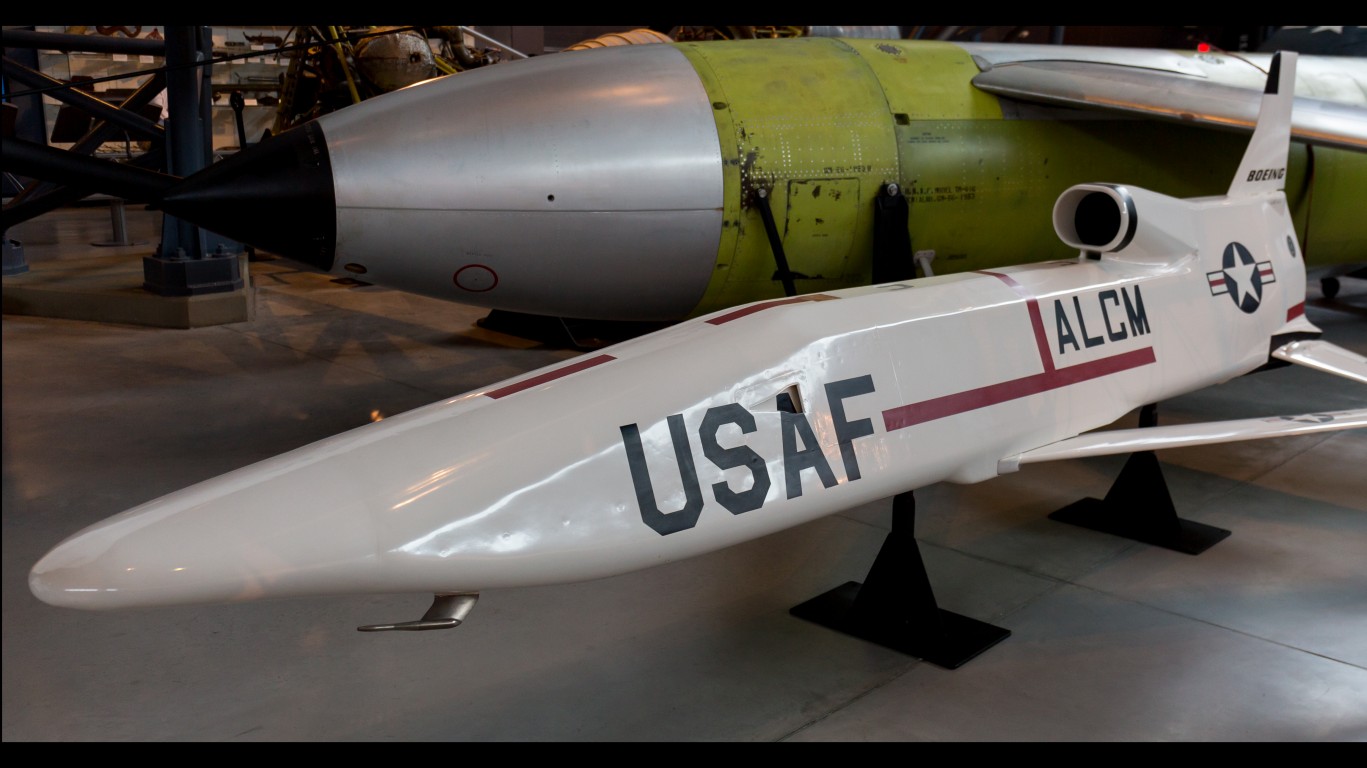
9. AGM-86 ALCM
> Bomb type: Strategic nuclear weapon
> Service branch user(s): U.S. Air Force
> Made by: Boeing
The AGM-86 Air-Launched Cruise Missile, or ALCM, is a nuclear strike weapon with a small radar signature designed for strategic surface targets. The missile is outfitted with a W80-1 nuclear warhead and can fly over 1,500 miles at speeds up to 550 mph.
Carried by B-52 bombers, the ALCMs are a key component of the U.S. nuclear triad. The other two components of the triad are long-range land-based intercontinental ballistic missiles and long-range submarine-launched ballistic missiles
[in-text-ad-2]

10. AGM-88e AARGM
> Bomb type: Air-to-surface weapon
> Service branch user(s): U.S. Air Force
> Made by: Northrop Grumman, Orbital ATK, and Northrop Grumman
The AGM-88e Advanced Anti-Radiation Guided Missile, or AARGM, is a weapon designed to target enemy air defenses and guidance radars, specifically surface-to-air missile systems. The missile can surpass Mach 2 speeds and carries a WAU-7/B warhead.
The system is currently integrated onto Navy F-18s, as well as F-16s and F-35s. It was developed as a replacement of the High-Speed Anti-Radiation Missile, or HARM, which proved deficient in Operation Iraqi Freedom. A single extended range AGM-88 costs a reported $6.1 million.
11. AIM-120 AMRAAM
> Bomb type: Air-to-air missile
> Service branch user(s): U.S. Navy, Marine Corps, and Air Force
> Made by: Raytheon, Northrop Grumman, and Nammo Group
The AIM-120 AMRAAM, or Advanced Medium-Range Air To Air Missile, is a new generation missile expected to be operational at least through 2050. The missile is 12 feet long with a range of over 20 miles, and though it is supersonic, its exact speed capabilities are classified.
A wide range of Navy and Air Force aircraft are equipped with AIM-120s, including F-18s, F-15s, F-16s, F-22s, and F35s. NATO forces also use the missile with Eurofighter jets. The price tag for a single AIM-120 is reportedly just over $1 million.
[in-text-ad]
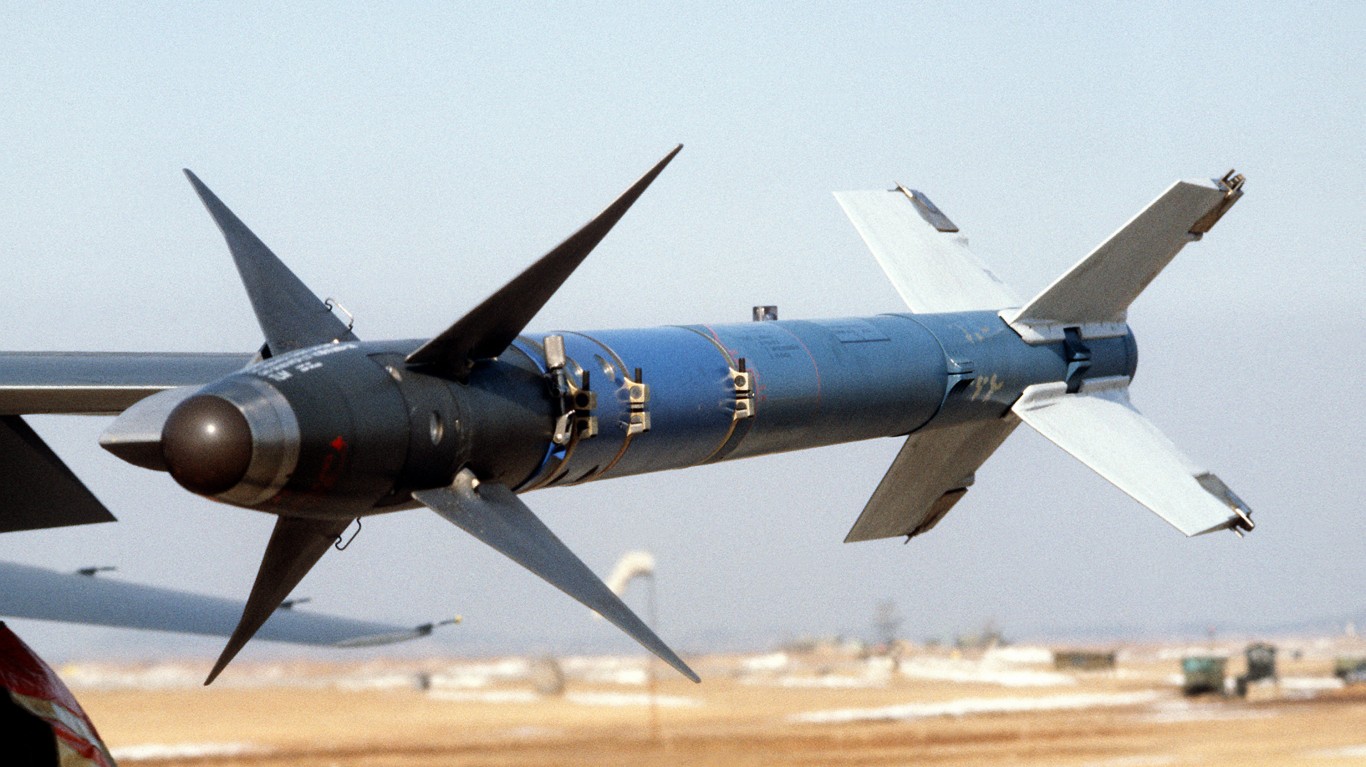
12. AIM-9 Sidewinder
> Bomb type: Air-to-air missile
> Service branch user(s): U.S. Navy and Air Force
> Made by: Raytheon and Northrop Grumman
AIM-9 Sidewinders are short-range – about 10 miles – supersonic air-to-air missiles, capable of speeds exceeding Mach 2. With infrared homing guidance, the missiles are designed to intercept and take down high-performance enemy aircraft.
At a price of just under half a million dollars a piece, AIM-9 Sidewinders are among the least expensive missiles in the U.S. arsenal. Used as far back as the Vietnam War, they are also one of the oldest and most successful. The missile is integrated onto a number of U.S. fighter jets, including the F-15, F-16, and F-22, and is used by over 40 nations worldwide.
13. B61 Thermonuclear Bomb
> Bomb type: Tactical nuclear weapon
> Service branch user(s): U.S. Air Force
> Made by: Los Alamos National Laboratory and Boeing
The B61 thermonuclear bomb, designed for tactical battlield use – as opposed to strategic nuclear bombs – are carried by certain F-16 and F-15 fighter jets as well as B-2 bombers. The bomb has preselectable blast yields that range from 0.3 kilotons to 50 kilotons depending on the mission goals. The bomb is also capable of ground penetration to improve its effectiveness against buried, harded targets.
The U.S. Air Force has approximately 500 B61 bombs in its arsenal.

14. BGM-71 TOW
> Bomb type: Anti-tank missile
> Service branch user(s): U.S. Army
> Made by: Raytheon
The BGM-71 TOW – which stands for Tube-launched, Optically-tracked, Wireless-guided missiles – is an anti-tank missile system used by the U.S. Army. They have a minimum range of 40 meters for close threats, and a maximum range of 2.3 miles, or 2.8 miles for extended range models.
These missiles are typically fired from a tripod mounted on a vehicle such as a Humvee but can also be used by some attack helicopters like the AH-1 Cobra.
[in-text-ad-2]

15. CBU-105 SFW
> Bomb type: Area weapon
> Service branch user(s): U.S. Air Force
> Made by: Textron Systems
The CBU-105 SFW – or Cluster Bomb Unit Sensor Fuzed Weapon – is a precision guided munition especially effective against tanks. The CBU-105 is a GPS equipped, and much more accurate, version of the CBU-97. Each CBU-105 packs a payload of 10 BLU-108 submunitions, each containing four target-seeking, explosive copper disks. A single CBU-105 has a lethal blast range of about 600,000 square feet.
The Geneva Convention on Cluster Munitions prohibits the production, transfer, and stockpiling of cluster munitions. The convention was signed by over 100 nations including the U.K., Canada, and all of Western Europe – but notably not the U.S. The American military is retaining cluster munitions, like the CBU-105, ostensibly for deterrence on the Korean Peninsula. The U.S. used CBUs in Iraq in 2003, though it has only used them in combat on one occasion since, according to the Air Force Magazine.
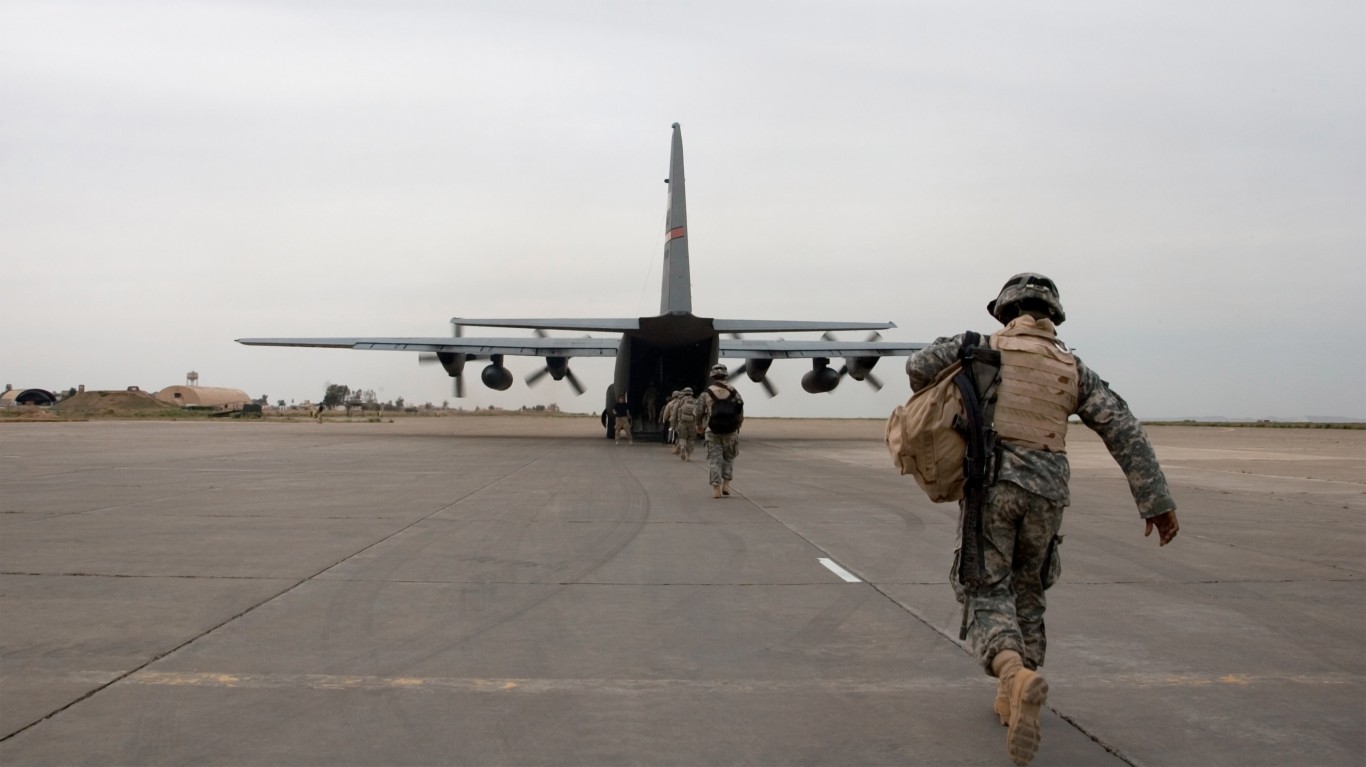
16. CBU-107 PAW
> Bomb type: Area weapon
> Service branch user(s): U.S. Air Force
> Made by: General Dynamics, Lockheed Martin, and Textron
The CBU-107 PAW – Passive Attack Weapon – is a non explosive weapon for use on sensitive targets – such as WMD stockpiles. The weapon works by gliding toward its target, and, before impact, it begins to spin and emit nearly 4,000 metal projectiles that can penetrate targets within 200 feet. The projectiles come in varying sizes – there are about 350 15-inch metal rods, 1,000 7-inch metal rods, and 2,400 nail-size metal rods.
The weapon was used during operation Iraqi Freedom and is carried by B-52 bombers as well as F-15 and F-16 fighters.
[in-text-ad]

17. Evolved Seasparrow Missile Block 1 (ESSM) (RIM 162D)
> Bomb type: Surface-to-air and surface-to-surface radar-guided missile
> Service branch user(s): U.S. Navy
> Made by: Raytheon
The Evolved Seasparrow Missile Block 1 (ESSM) (RIM 162D) is a medium-range, semi-active homing missile designed for ship self defense – either against enemy cruise missiles or certain aircraft, such as helicopters.
The missile system is used by the U.S. Navy on a number of surface vessels, including DDG 51 and DDG 1000 destroyers, as well as by several other nations such as Australia, Denmark, Germany, and Thailand. Depending on the configuration, the unit price of these missiles ranges from $787,000 to $972,000.
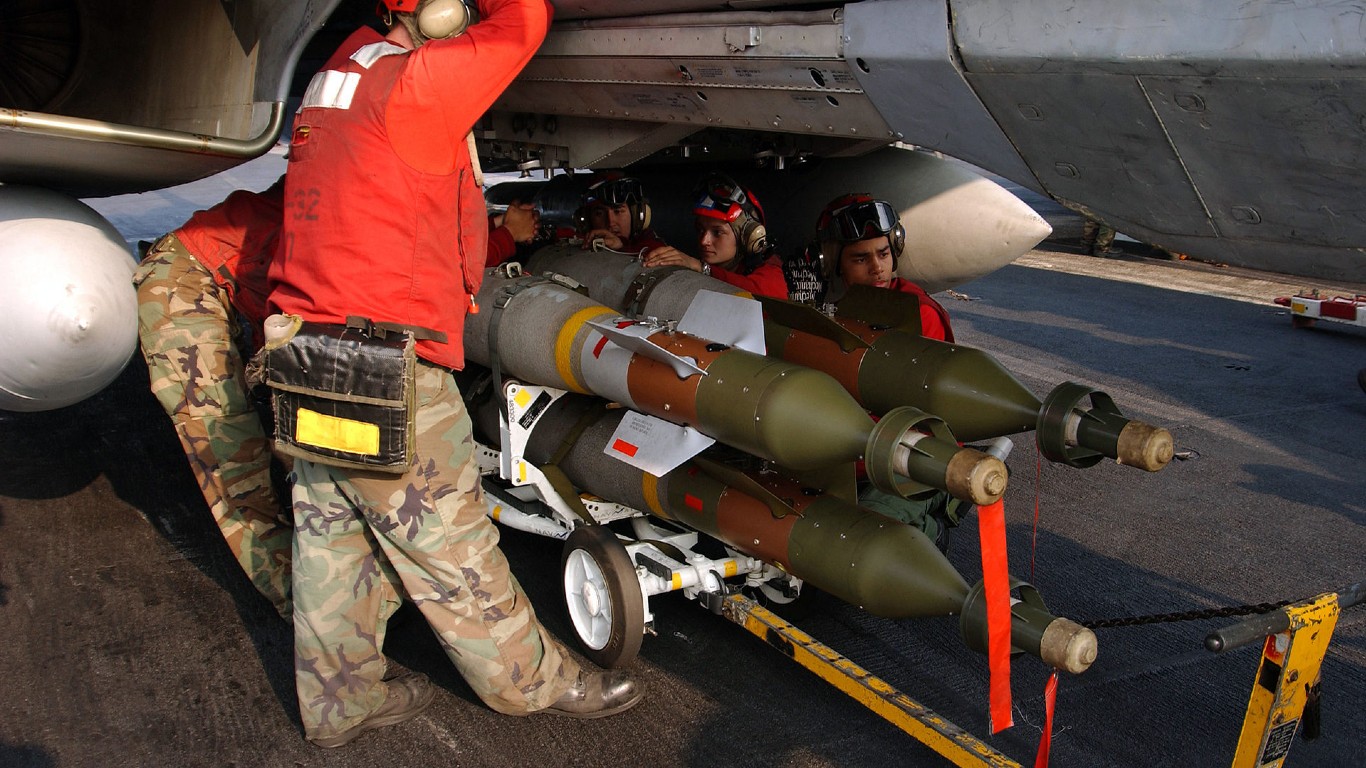
18. GBU-10/12/49 Paveway II
> Bomb type: Precision-guided air-to-surface weapon
> Service branch user(s): U.S. Air Force
> Made by: Lockheed Martin and Raytheon
The Paveway II is a laser-guided, free-fall bomb that cam be equipped with warheads of varying sizes. The GBU-10 is a 2,000 pound general bomb typically used for non-hardened targets. The GBU-12 and the GBU-49 are both a 500 pound bomb, but the former is used against stationary armored targets and the latter is also equipped with GPS for precision all-weather use against moving targets.
Paveway IIs are currently fitted onto B-1 and B-2 bombers, as well as F-15, F-16, and F-35 fighters and Reaper drones.
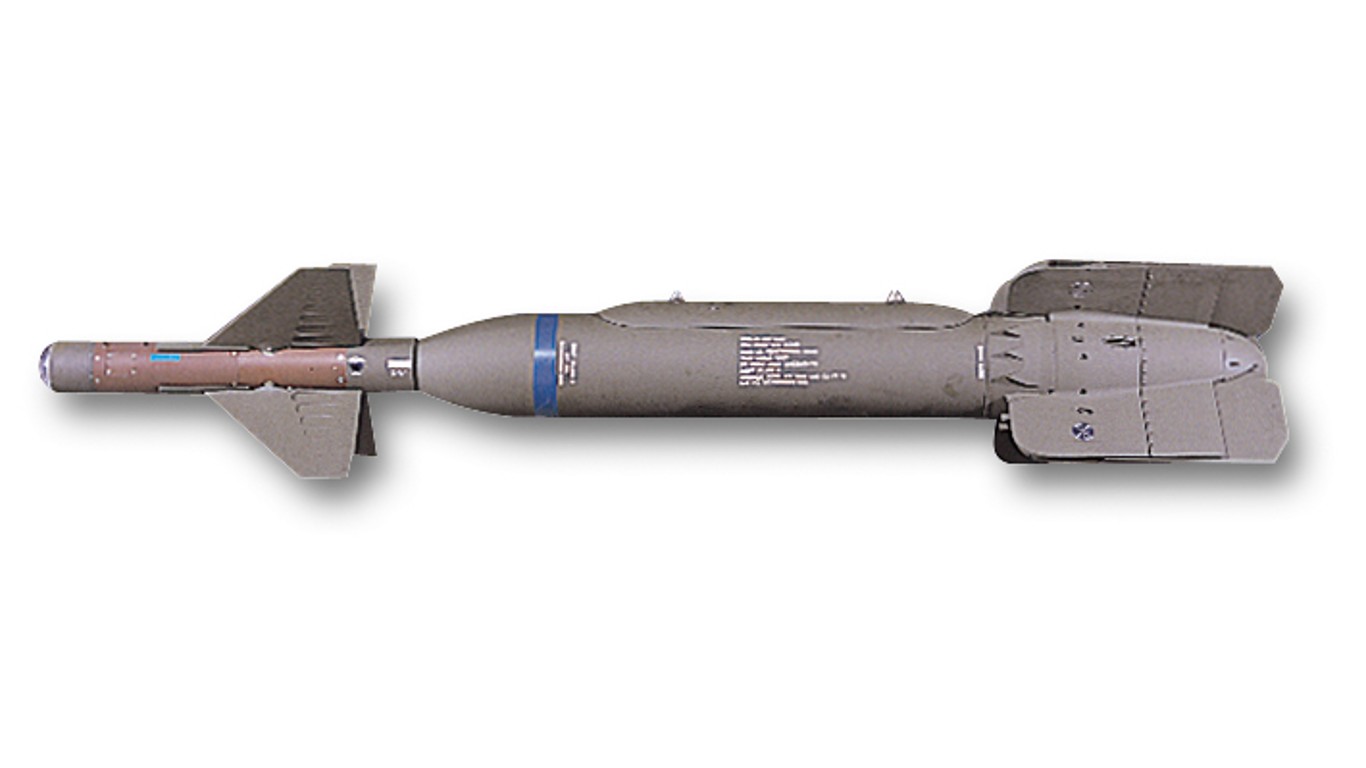
19. GBU-24/28 Paveway III
> Bomb type: Precision-guided air-to-surface weapon
> Service branch user(s): U.S. Air Force
> Made by: Raytheon
GBU-24 and 28 Paveway IIIs are free-fall bombs that offer greater precision than Paveway II bombs. With third-generation laser guidance, Paveway IIIs can deliver their payload from virtually any altitude.
The GBU 24 warhead is a 2,000 pound bomb penetrating warhead, and the GBU 28 warhead is a 5,000 pound warhead designed specifically for deeply buried and hardened facilities in Iraq. Both weapons have been integrated onto the B-52 bomber and F-15 fighter, while the F-16 is eqipped only for the GBU-24, and the B-2 bomber only for the GBU-28.
[in-text-ad-2]
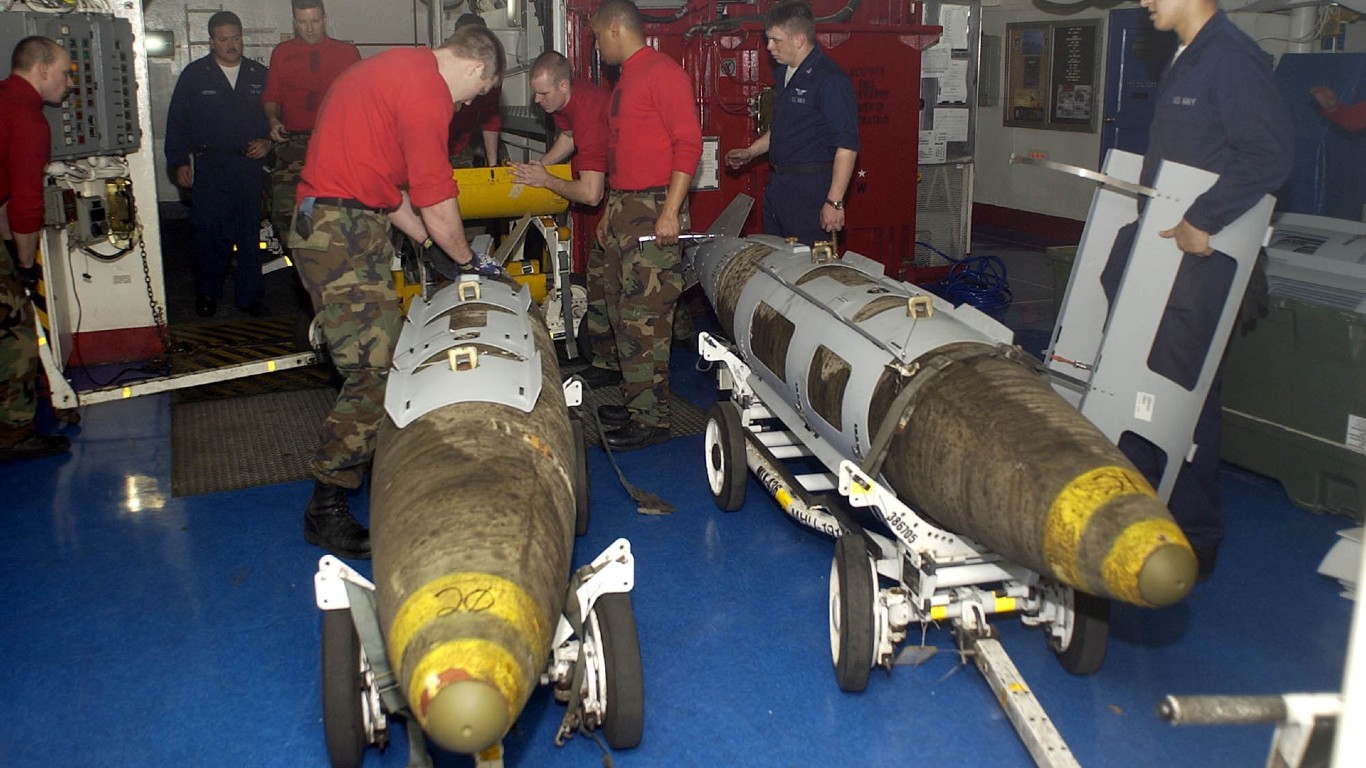
20. GBU-31/32/38 JDAM
> Bomb type: Precision-guided air-to-surface weapon
> Service branch user(s): U.S. Air Force, Navy
> Made by: Boeing, Textron, and Honeywell
The GBU-31/32/38 Joint Direct Attack Munition, or JDAM, is a GPS guided all-weather surface attack bomb. JDAM-class weapons are the most commonly used air-to-ground combat weapons in the U.S. military.
The GBU 31 variant carries a 2,000 pound warhead, while the GBU 32 carries a 1,000 pound warhead. Each variant is carried by a range of bombers and fighters, including the B-52H, B-2A, B-1B, F-15E, F-16, and F-22A. The GBU 38 variant, meanwhile, packs a 500 pound payload and is carried by the MQ-9 Reaper drone.
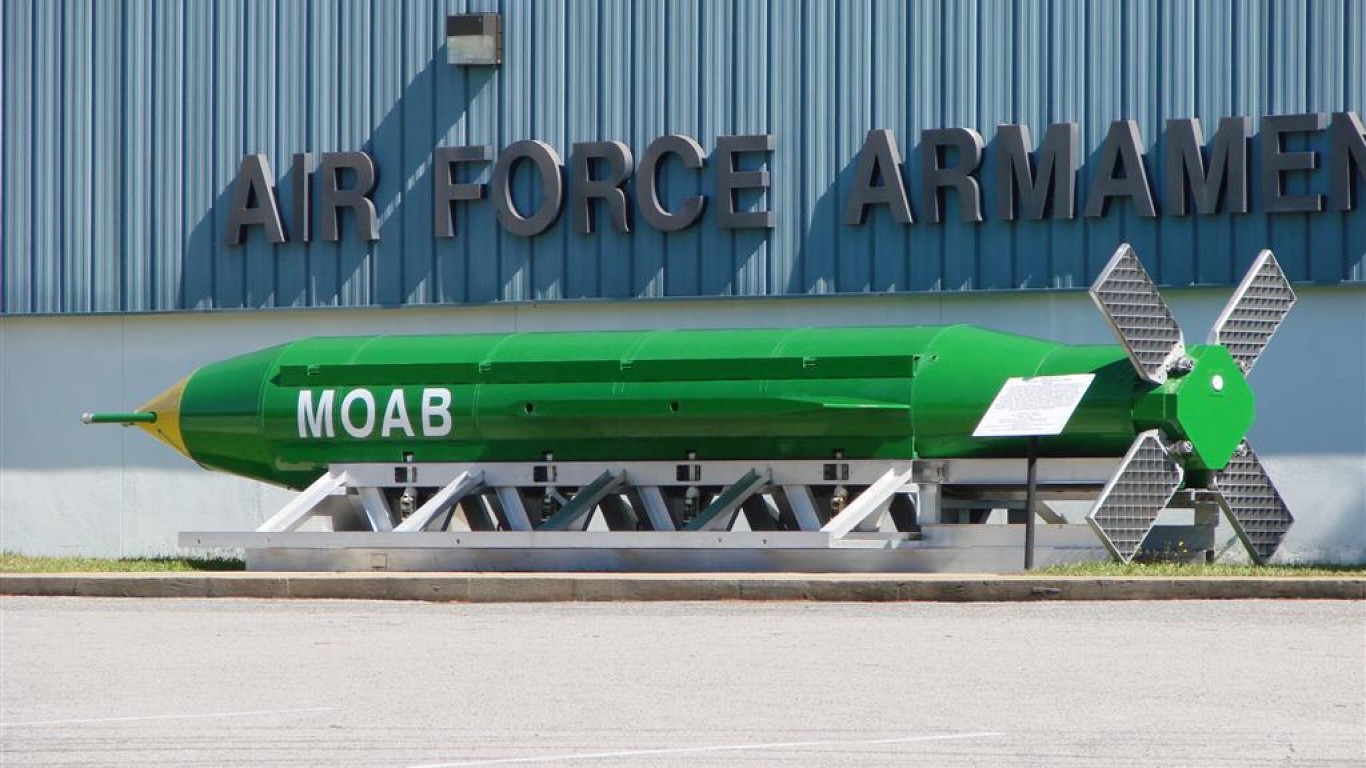
21. GBU-43 MOAB
> Bomb type: Precision-guided munitions
> Service branch user(s): U.S. Air Force
> Made by: AFRL and Dynetics
The GBU-43 MOAB is the most powerful non-nuclear bomb ever used by the U.S. in combat. Though it stands for Massive Ordnance Air Blast, MOAB is colloquially referred to as the Mother of All Bombs. The GBU-43 weighs some 21,000 pounds, 18,700 of which are packed into its warhead. The weapon is so large, it cannot be carried by a traditional bomber and is instead dropped from the back of a MC-130 cargo plane.
The bomb is designed for use over large areas as well as deeply buried targets and tunnels or caves. Available for use since 2003, the MOAB was never used in combat until April 2017, when it was used to take out a cave complex in Afghanistan used by ISIS militants. At least 94 ISIS militants are reported to have been killed in the blast.
[in-text-ad]
22. GBU-53 StormBreaker
> Bomb type: Precision-guided munitions
> Service branch user(s): U.S. Air Force, Navy
> Made by: Raytheon
The GBU-53 StormBreaker is a precision bomb capable of being reguided after release and designed to strike moving targets in any weather from as far as 46 miles out. The weapon is currently integrated on F-15E fighter jets and is soon exptected to equip other aircraft, including the B-1, B-2, and B-52 bombers as well as F-16 and F-22 fighters and MQ-9 Reaper drones. A single StormBreaker bomb reportedly costs the Air Force $195,000 and the Navy $220,916.

23. GBU-54 LDJAM
> Bomb type: Precision-guided munitions
> Service branch user(s): U.S. Air Force, Navy
> Made by: Boeing
The GBU-54 LDJAM, or Laser Joint Direct Attack Munition, is an attack weapon designed for moving or stationary targets. Developed in less than a year and a half out of operational necessity, it was first used in Iraq in 2008.
The system is GPS and laser guided and packs a 500 pound warhead. There is also a variant – the GBU-56 – with a 2,000 pound penetrating warhead. GBU-54s are currently integrated onto F-15 and F-16 fighters.

24. GBU-57 MOP
> Bomb type: Precision-guided munitions
> Service branch user(s): U.S. Air Force
> Made by: Boeing
The GBU-57 MOP, or Massive Ordnance Penetrator, is reportedly the heaviest non-nuclear bomb in the U.S. Air Force arsenal. Though its yield is smaller than a MOAB, its weight of 30,000 pounds, including a more than 5,000 pound warhead, allows it to penetrate hardened targets and underground facilities – earning it the moniker “bunker buster.” MOPs are currently integrated for use on B-2 bombers.
[in-text-ad-2]
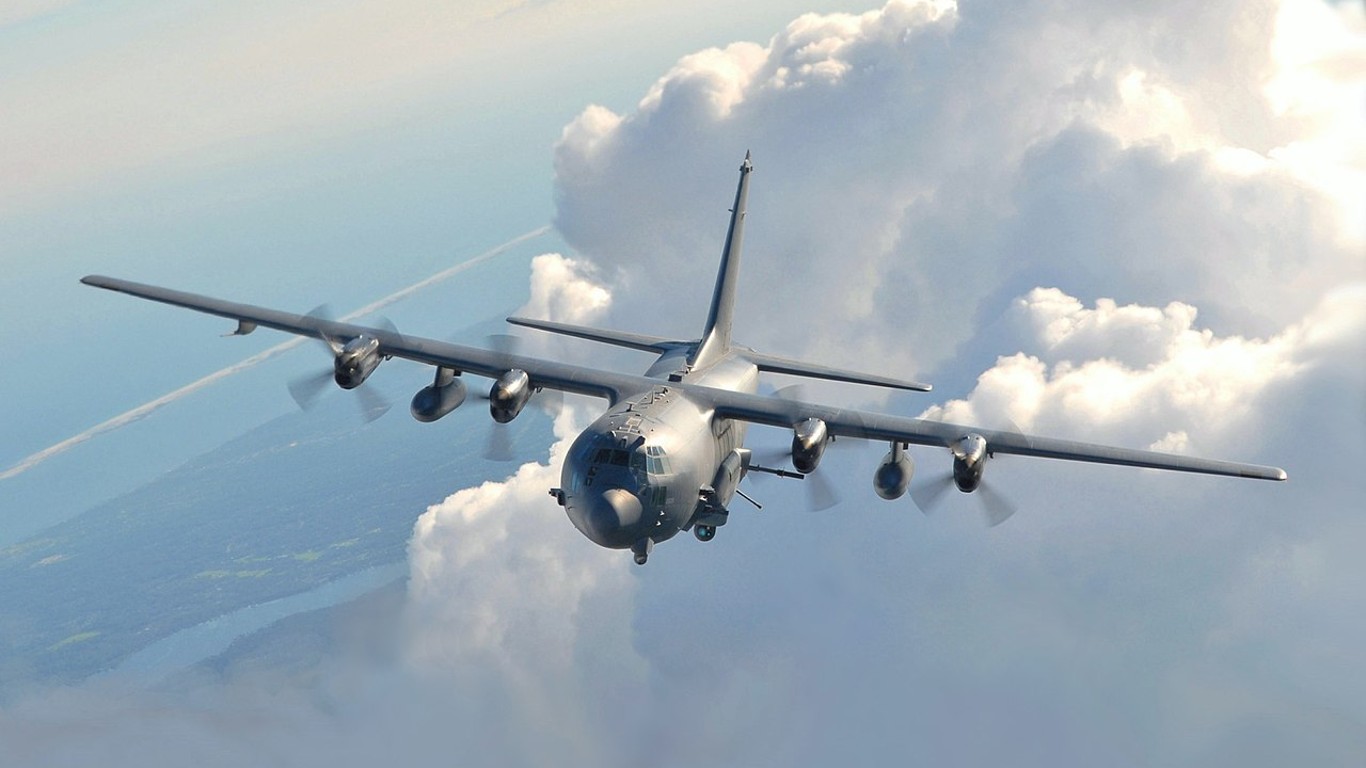
25. GBU-69 Small Glide Munition
> Bomb type: Precision-guided munitions
> Service branch user(s): U.S. Air Force
> Made by: Dynetics
The GBU-69 Small Glide Munition is a laser guided missile system equipped with a 36 pound warhead. With a laser guidance system, the weapon is accurate up to 20 miles. GBU-69s are integrated onto AC-130 aircraft and have been used in east Africa against al Shabaab militants.
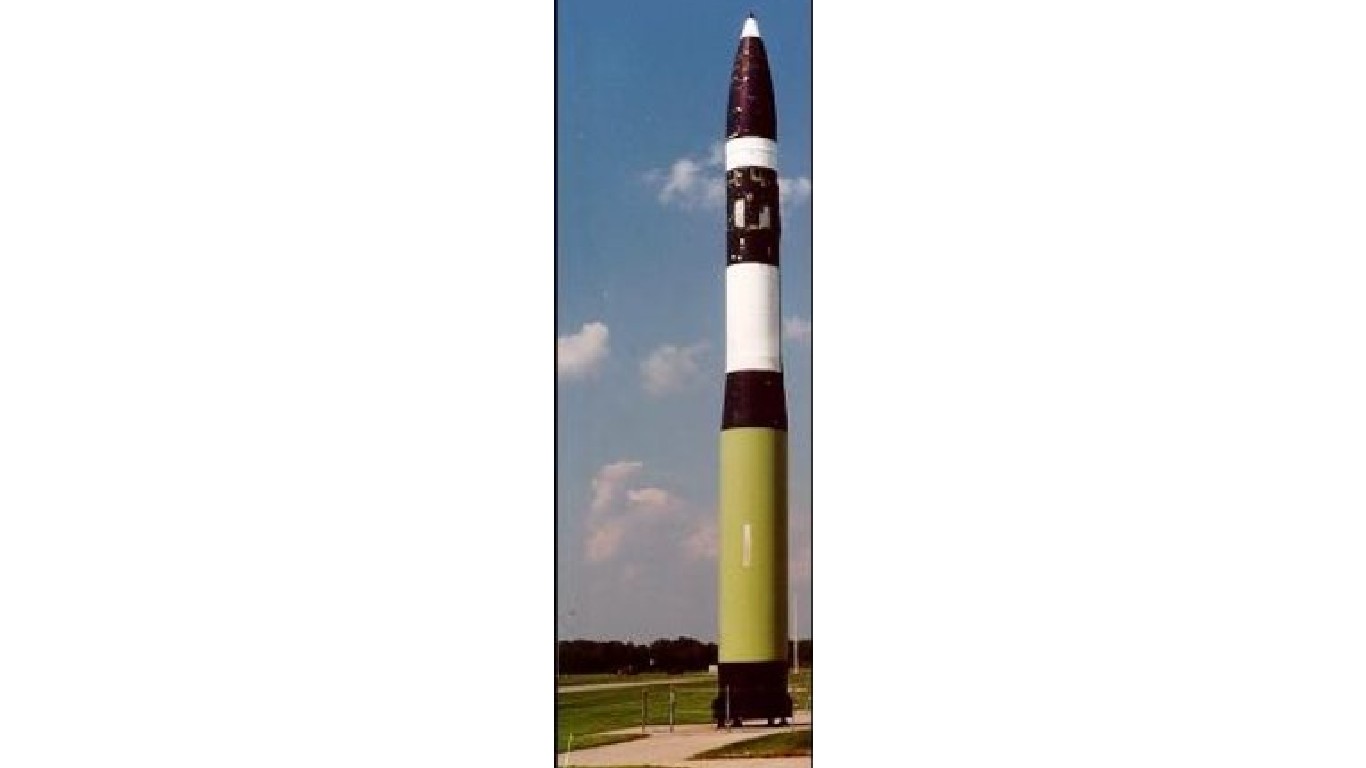
26. LGM-30 Minuteman III
> Bomb type: Strategic nuclear weapon
> Service branch user(s): U.S. Air Force
> Made by: Boeing, General Electric, Lockheed Martin, and Northrop Grumman
The LGM-30 Minuteman III are the only remaining land-based nuclear intercontinental ballistic missiles in the U.S. arsenal. Housed in underground silos, Minuteman IIIs are one leg of the U.S. nuclear triad policy.
The ICBMs are capable of flying at about 15,000 mph and have a range of over 6,000 miles. They can be equipped with either one W87 or as many as three W78 thermonuclear warheads.
[in-text-ad]

27. MGM-140/164/168 ATACMS
> Bomb type: Surface-to-surface missile system
> Service branch user(s): U.S. Army
> Made by: Lockheed Martin
The MGM series of Army Tactical Missile Systems – ATACMS – are short range surface-to-surface ballistic missiles that are road-mobile.They have a maximum range of nearly 200 miles and carry warheads weighing between 350 and 1,200 pounds. In service since 1986, they were first used in combat in 1991 during the Gulf War.

28. MIM-104 Patriot
> Bomb type: Surface-to-air missile system
> Service branch user(s): U.S. Army
> Made by: Raytheon, Lockheed Martin, and Boeing
The MIM-104 Patriot is the primary missile defense system used by the U.S. Army. The system uses multiple types of interceptors designed to detect and take down enemy ballistic missiles, cruise missiles, drones, and advanced aircraft.
Patriot guided missiles are launched from four canisters on a trailer, typically containing multiple launching stations. The Patriot system was first used in the 1991 Gulf War, where it occasionally failed to destroy incoming missiles. Deployed in Iraq once again in 2003, the system was more effective, taking down a British Tornado fighter-bomber and a U.S. F-18 in two accidental friendly fire incidents that resulted in three deaths.
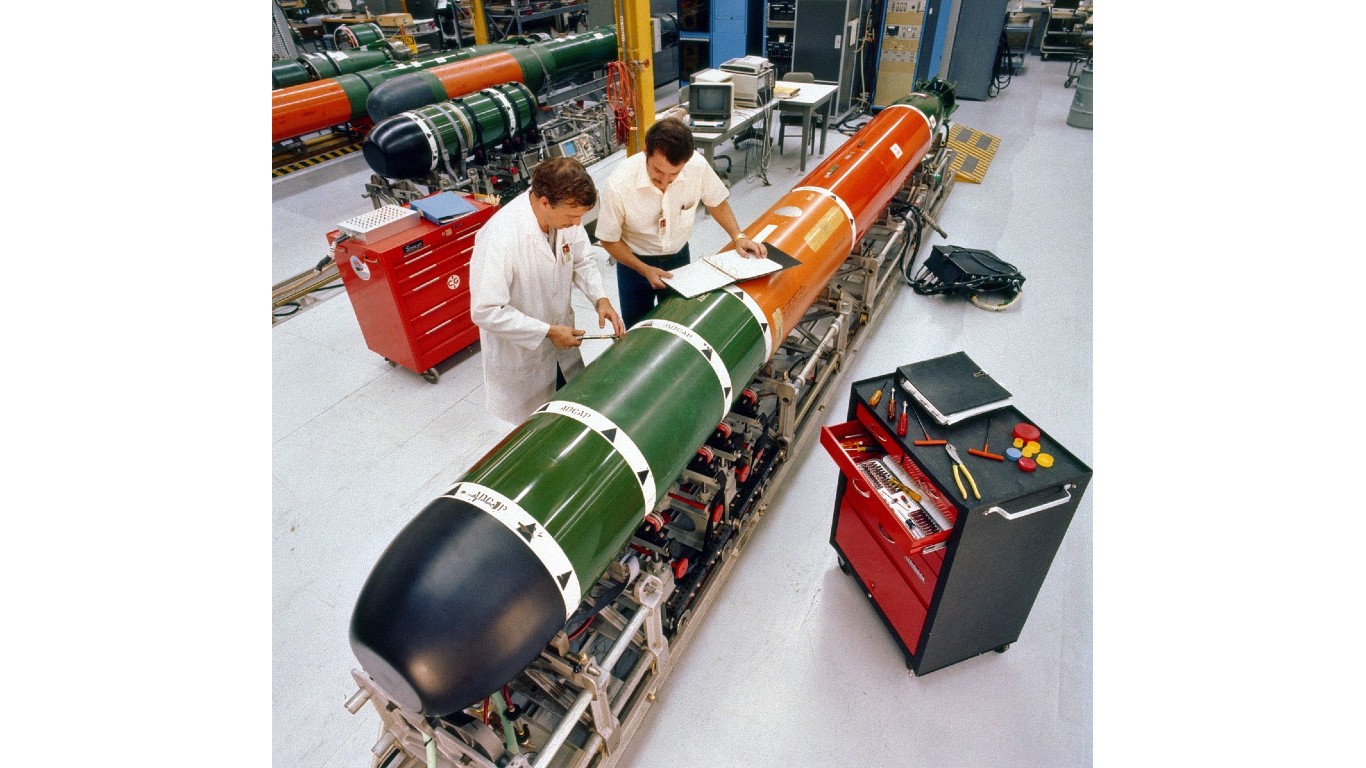
29. MK Family of Torpedoes
> Bomb type: Anti-submarine weapon
> Service branch user(s): U.S. Navy
> Made by: Raytheon
The MK family of torpedoes, including the MK 46, MK 48, MK 50, and MK 54, are weapons deployed on various platforms by the U.S. Navy. Primarily used as anti-submarine and surface vessel weapons, variations of these weapons equip Navy aircraft and surface ships as well as submarines. Some are mounted on the Navy’s Vertical Launch Anti-Submarine Rocket carried by cruisers and destroyers.
The largest of these bombs is the MK 48 Heavyweight Torpedo, which is equipped with a 650 pound warhead and can be found on all classes of U.S. Navy submarines.
[in-text-ad-2]

30. NGAAW
> Bomb type: Area weapon
> Service branch user(s): U.S. Air Force
> Made by: Major Tool & Machine and Faxon Machining
Facing backlash over the use of cluster bombs, the U.S. military developed the Next Generation Area Attack Weapon (NGAAW) as an alternative. Still in the development phase, the NGAAW can be fitted with either a 2,000 or 500 pound warhead. Testing shows the weapon is effective against light vehicles, structures, and personnel within a 225 foot radius.
31. RIM-116 Rolling Airframe Missile (RAM)
> Bomb type: Ship self defense
> Service branch user(s): U.S. Navy
> Made by: Raytheon
An American and German joint development, the RIM-116 Rolling Airframe Missile (RAM), is a powerful lightweight and low cost system designed for defense against cruise missiles and other threats from the air and surface. The majority of U.S. Navy ship classes, as well as many patrol boats, aircraft carriers, and destroyers, are outfitted with variants of the RIM-116 system.
[in-text-ad]

32. Seasparrow Missile (RIM-7)
> Bomb type: Surface-to-air missile
> Service branch user(s): U.S. Navy
> Made by: Raytheon and General Dynamics
The Seasparrow is a radar guided homing missile designed to defend against a range of air and surface threats. Navy aircraft carriers and amphibious assault ships are all equipped with the Seasparrow RIM-7 system.
The top speed and range of these missiles are classified, though they each carry a 90 pound warhead. As of 2019, a single seasparrow missile cost a reported $165,400.
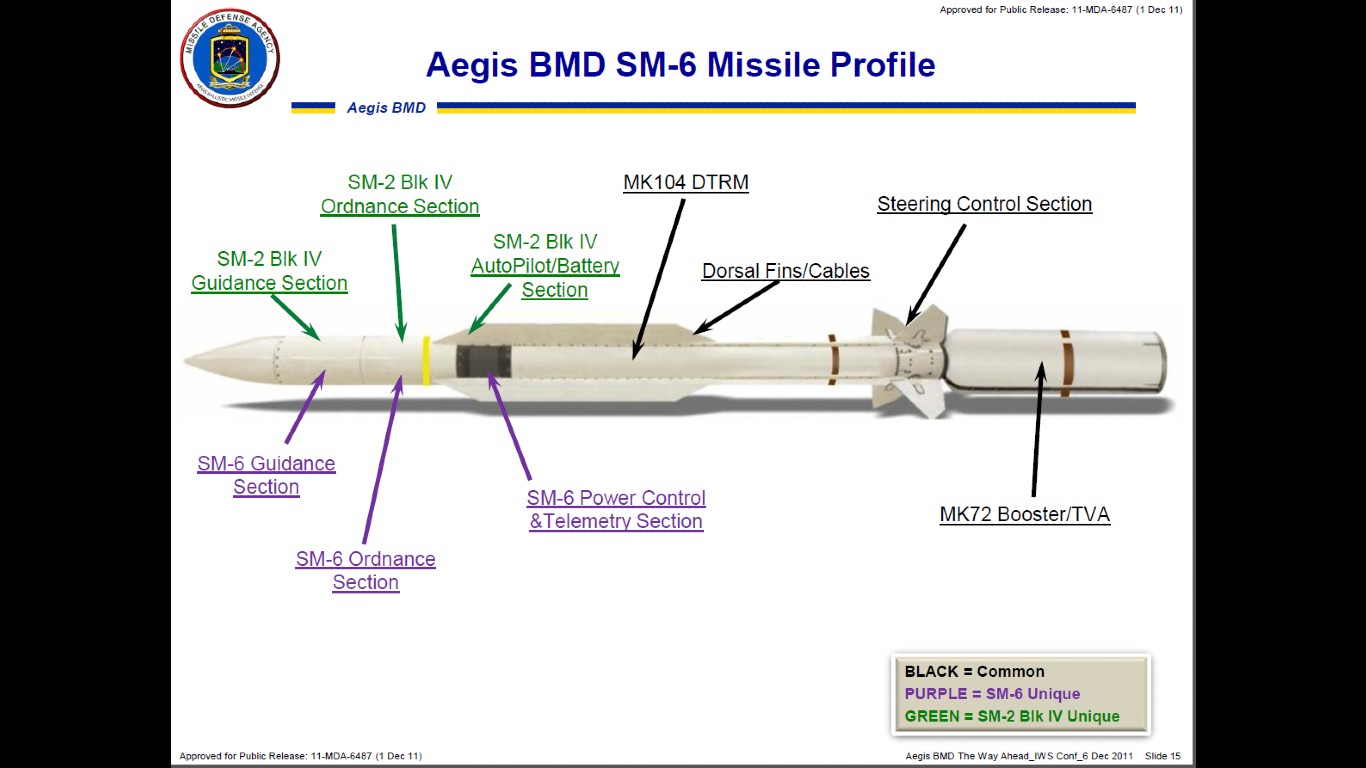
33. Standard Missile Family
> Bomb type: Surface-to-air, surface-to-surface missile
> Service branch user(s): U.S. Navy
> Made by: Raytheon
The Standard Missile family serves as the U.S. Navy’s primary surface-to-air defense and surface-to-surface missile. The Standard Missile-6, the latest and most advanced iteration of the weapon, has an extended range – of about 230 miles – and capability, able to not only defend against cruise missiles, but also aerial drones and surface ships.
34. Tomahawk Cruise Missile
> Bomb type: Long -ange subsonic cruise missile
> Service branch user(s): U.S. Navy
> Made by: Raytheon
Tomahawk Land Attack Missiles are carried by U.S. Navy surface ships and submarines for the purposes of deep land attack. Tomahawks are low flying with a range up to 1,000 miles and a 1,000 pound payload. They were first used in combat during Operation Desert Storm in 1991,
[in-text-ad-2]

35. Trident II (D5) Missile
> Bomb type: Submarine launched strategic nuclear missiles
> Service branch user(s): U.S. Navy
> Made by: Lockheed Martin and Space Co.
The Trident II (D5) ballistic missiles make up one of the three legs of the U.S. nuclear triad strategy. Deployed on Ohio-class submarines, Trident are submarine-launched ballistic missiles. This leg is considered the most survivable leg of the triad. Each Ohio-class submarine can hold up to 20 of these missiles, which weigh 130,000 pounds and have a range of 4,600 miles.
Trident missiles can be equipped with multiple nuclear warheads at once and cost a reported $30.9 million each.
Is Your Money Earning the Best Possible Rate? (Sponsor)
Let’s face it: If your money is just sitting in a checking account, you’re losing value every single day. With most checking accounts offering little to no interest, the cash you worked so hard to save is gradually being eroded by inflation.
However, by moving that money into a high-yield savings account, you can put your cash to work, growing steadily with little to no effort on your part. In just a few clicks, you can set up a high-yield savings account and start earning interest immediately.
There are plenty of reputable banks and online platforms that offer competitive rates, and many of them come with zero fees and no minimum balance requirements. Click here to see if you’re earning the best possible rate on your money!
Thank you for reading! Have some feedback for us?
Contact the 24/7 Wall St. editorial team.
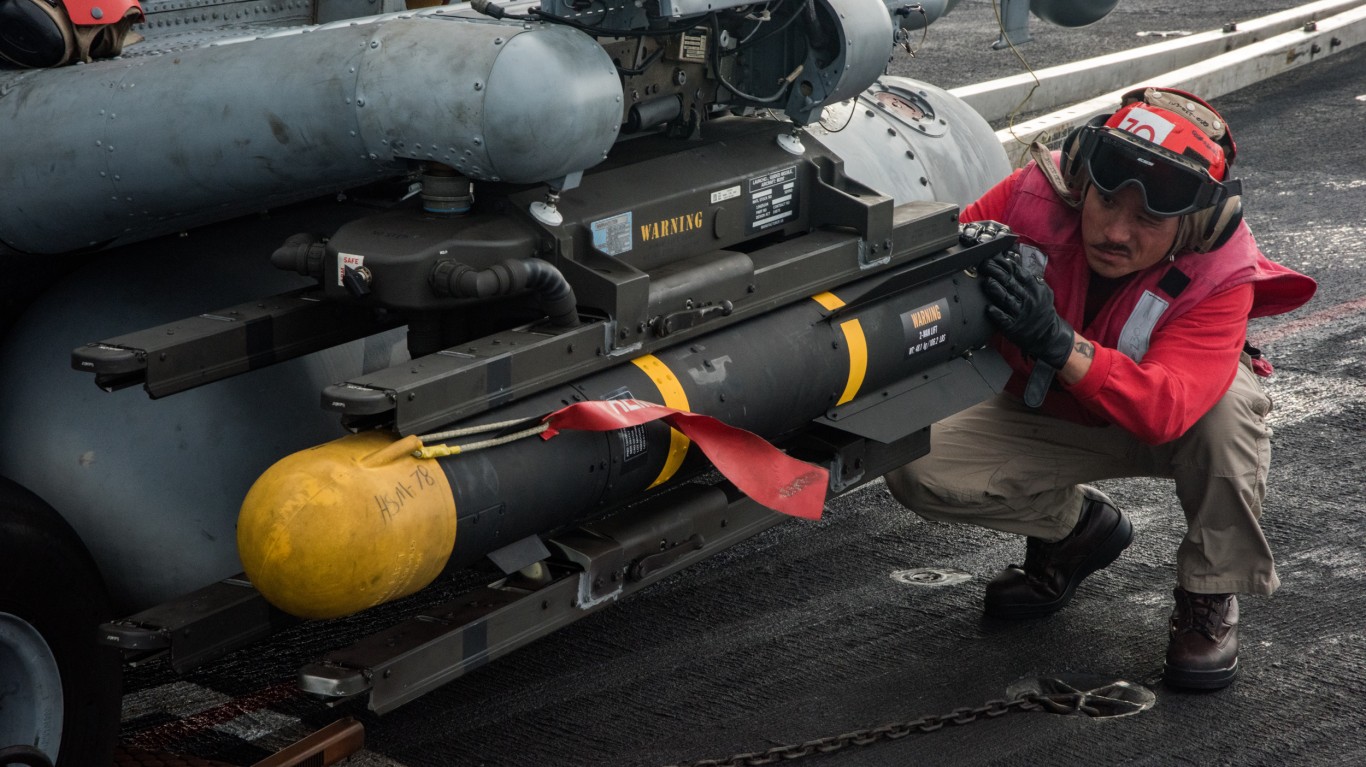
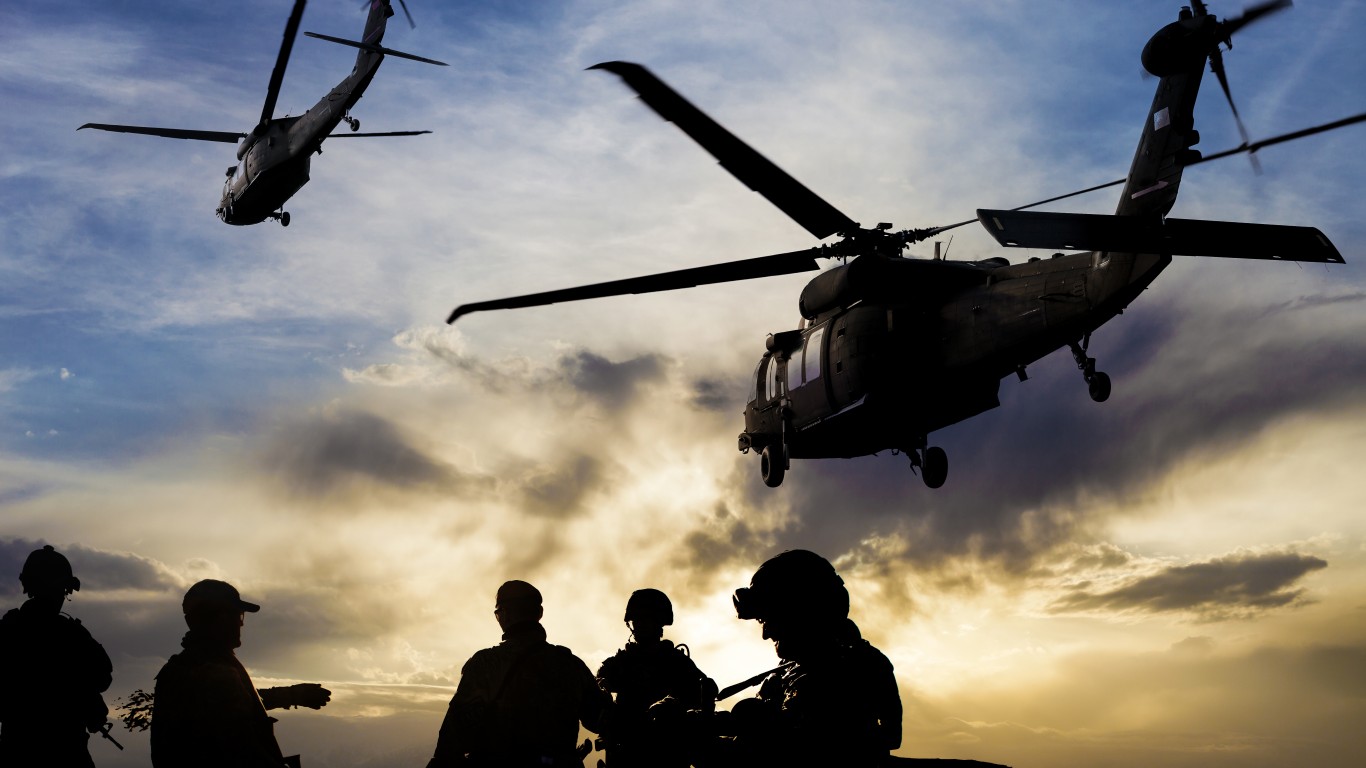 24/7 Wall St.
24/7 Wall St. 24/7 Wall St.
24/7 Wall St.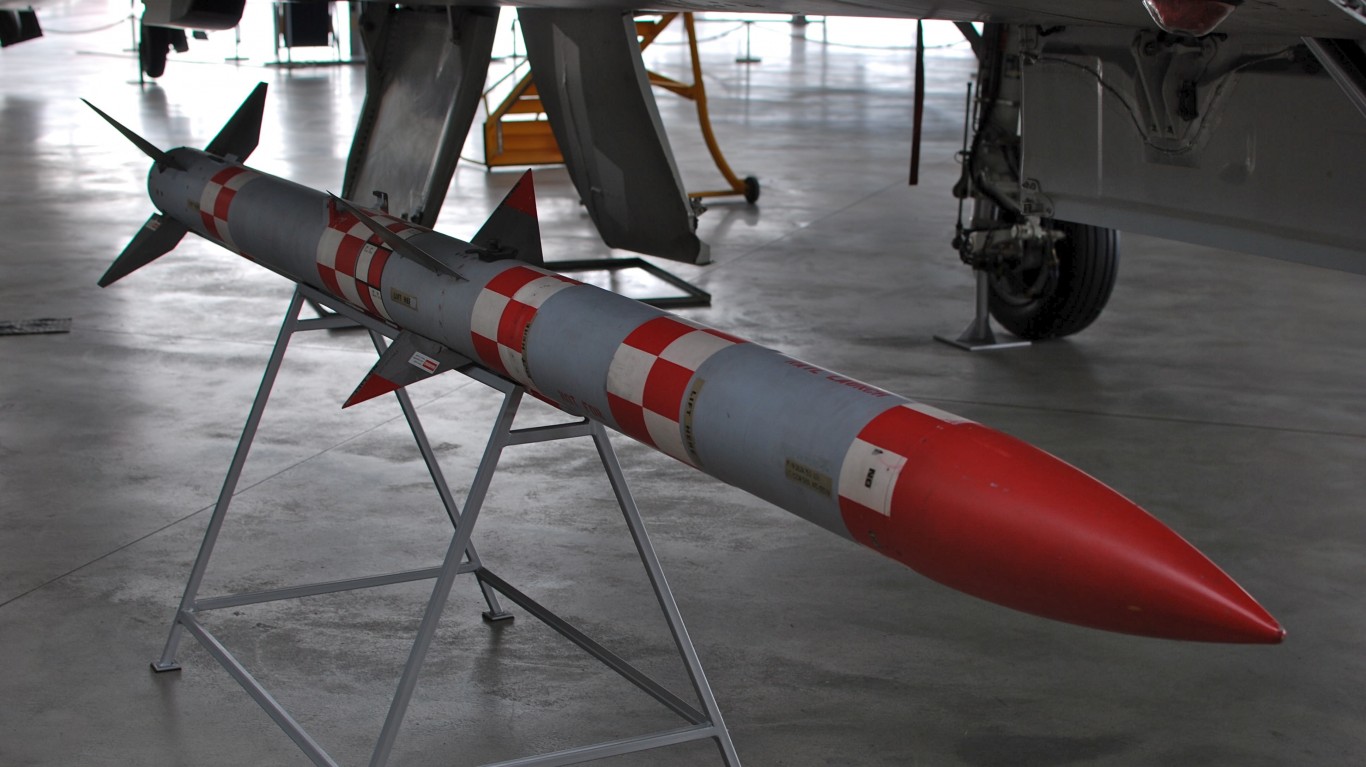
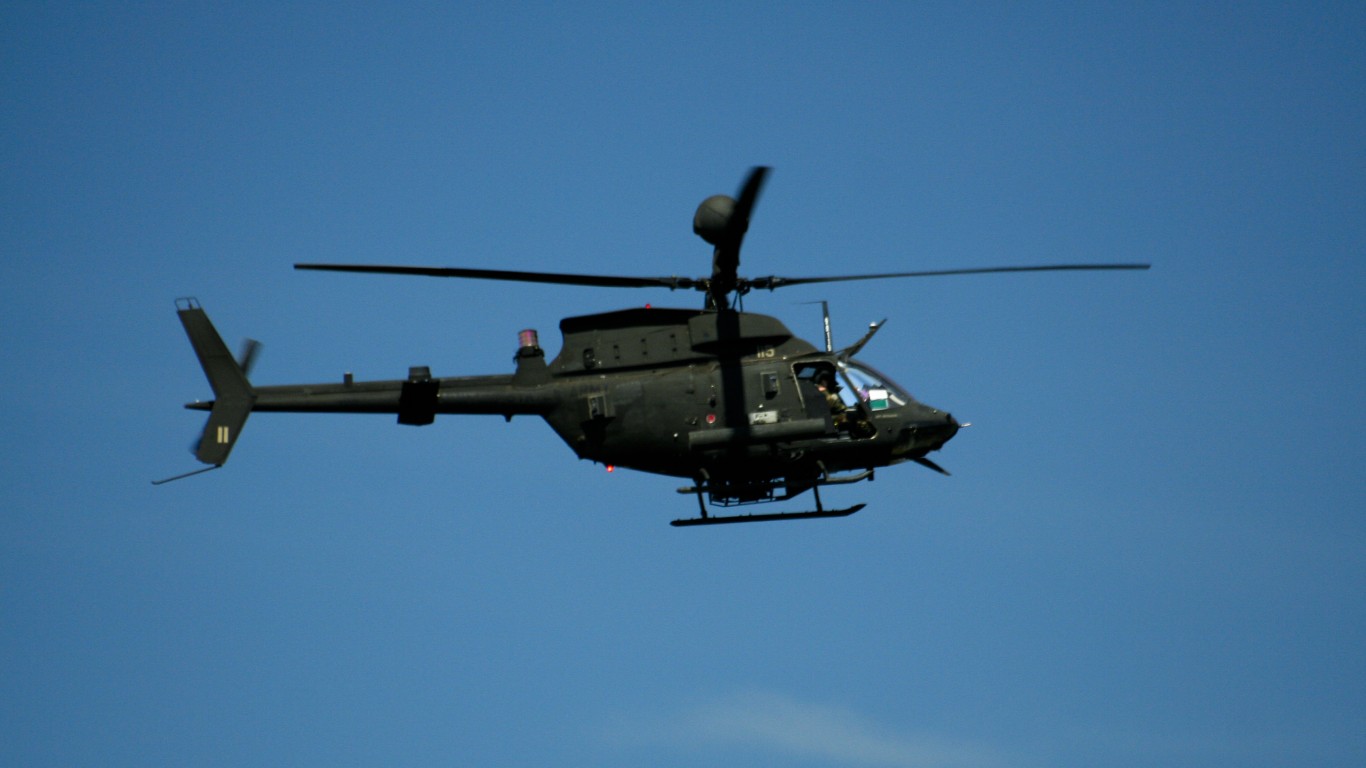 24/7 Wall St.
24/7 Wall St.